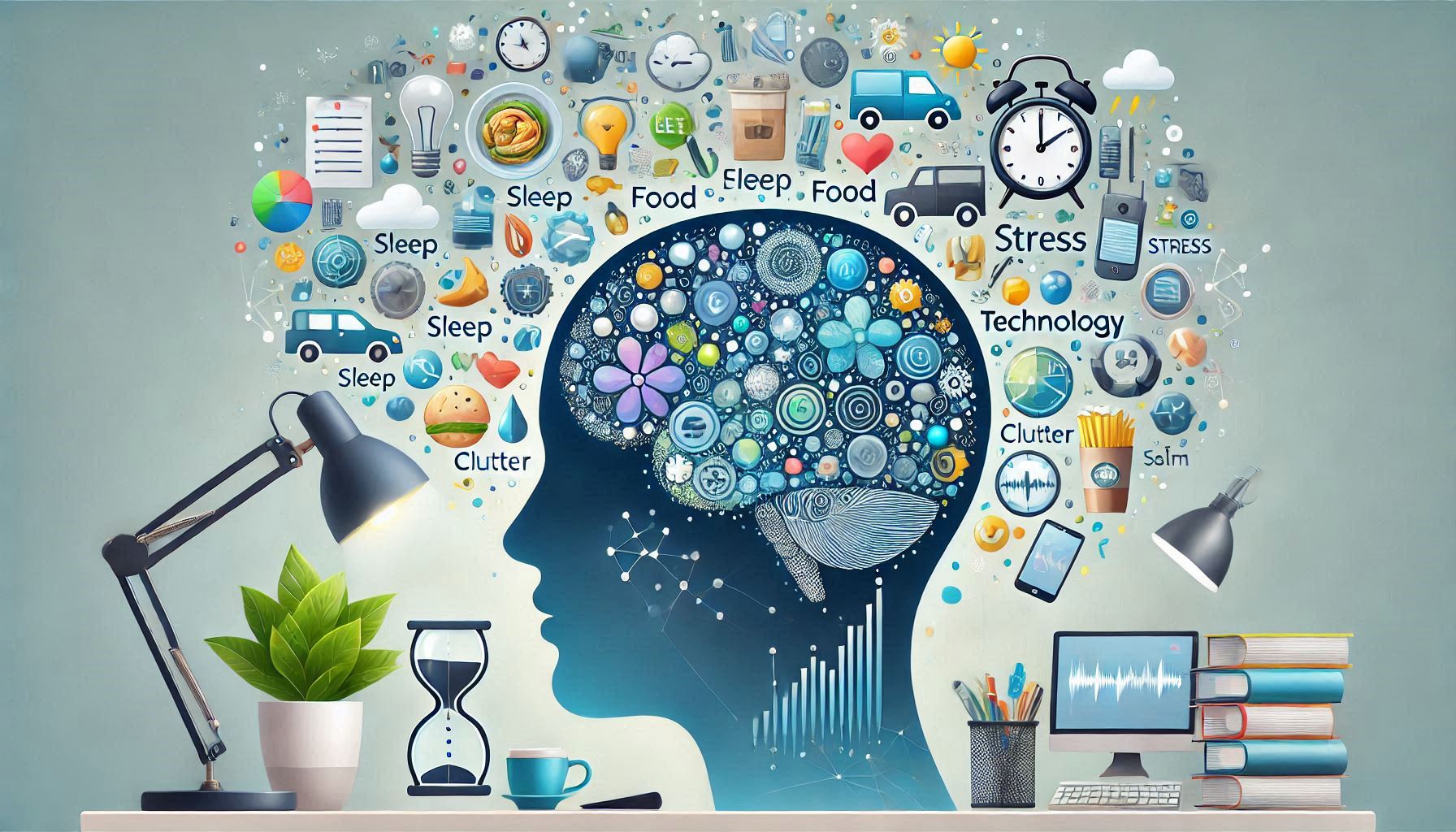Anxiety is a natural response to stress, but when it becomes persistent or overwhelming; it can interfere with daily life. While major life events or trauma are well-known triggers, many people are unaware of the everyday factors that can quietly contribute to anxiety. These hidden causes—like poor sleep habits, dietary choices, or excessive technology use—can exacerbate symptoms over time. Understanding and addressing these subtle influences is essential for managing anxiety effectively.
1. The Sleep-Anxiety Connection
Good sleep is essential for mental and emotional health. Yet, many people struggle with inadequate or poor-quality sleep, often without realizing its significant impact on anxiety. Sleep deprivation can heighten the brain’s reactivity to stress, making it harder to cope with challenges.
How Sleep Affects Anxiety
- Increased Cortisol Levels: Sleep deprivation leads to higher levels of cortisol, the body’s stress hormone, which can intensify feelings of worry or unease.
- Impaired Emotional Regulation: Lack of sleep disrupts the prefrontal cortex, the part of the brain responsible for decision-making and emotional regulation. This can lead to heightened emotional responses and difficulty calming down.
- Overactive Amygdala: The amygdala, the brain’s “fear center,” becomes more sensitive with insufficient sleep, amplifying anxious thoughts and fears.
Tips for Better Sleep
- Create a Sleep Routine: Go to bed and wake up at the same time every day to regulate your internal clock.
- Limit Screen Time: Avoid screens at least an hour before bedtime, as blue light can disrupt melatonin production.
- Optimize Your Sleep Environment: Ensure your bedroom is cool, dark, and quiet. Consider blackout curtains and white noise machines if needed.
2. Diet: Food as a Friend or Foe
The link between diet and mental health is becoming increasingly clear. What we eat not only fuels our bodies but also affects brain chemistry and mood regulation. Certain foods can either soothe or worsen anxiety, depending on their nutritional content.
Hidden Dietary Triggers
- Caffeine: While a morning coffee might seem harmless, excessive caffeine intake can mimic anxiety symptoms such as restlessness, rapid heartbeat, and jitteriness.
- Sugar: High-sugar diets can cause blood sugar spikes and crashes, leading to mood swings and increased anxiety.
- Processed Foods: These often lack essential nutrients and can contain additives that disrupt gut health, which plays a vital role in mental well-being.
Foods That Help Reduce Anxiety
- Omega-3 Fatty Acids: Found in salmon, walnuts, and flaxseeds, omega-3s support brain health and reduce inflammation linked to anxiety.
- Magnesium-Rich Foods: Leafy greens, nuts, and seeds are rich in magnesium, a mineral known to have calming effects on the nervous system.
- Probiotics: Yogurt, kimchee, and kefir can promote a healthy gut micro biome, which influences mood and anxiety levels.
3. Technology Overload and Anxiety
The digital age has brought unparalleled convenience but also new challenges for mental health. Excessive screen time, constant notifications, and exposure to negative online content can all contribute to anxiety.
How Technology Fuels Anxiety
- Information Overload: Constant exposure to news and social media can overwhelm the brain, increasing feelings of stress and helplessness.
- Comparison Culture: Social media often presents an idealized version of others’ lives, leading to self-comparison and feelings of inadequacy.
- Disrupted Downtime: Even leisure time can become stressful when spent passively scrolling through screens instead of engaging in meaningful activities.
Ways to Use Technology Mindfully
- Set Screen Time Limits: Use apps or built-in phone settings to monitor and reduce daily screen time.
- Curate Your Feed: Follow accounts that inspire or uplift you and follow those that trigger negative emotions.
- Practice Digital Detox: Schedule regular breaks from technology, such as a no-phone hour before bed or a screen-free weekend.
4. The Role of Physical Activity
While exercise is often touted as a solution for anxiety, the lack of physical activity can be a subtle but significant trigger. Sedentary lifestyles are common due to desk jobs, long commutes, and screen-based entertainment. This inactivity can contribute to anxiety by reducing the body’s production of mood-enhancing chemicals.
Why Exercise Matters
- Endorphin Boost: Physical activity releases endorphins, which are natural mood elevators.
- Stress Hormone Reduction: Exercise helps lower cortisol levels, alleviating the physical symptoms of anxiety.
- Improved Sleep: Regular exercise can promote deeper and more restful sleep, indirectly reducing anxiety.
Getting Started with Movement
- Start Small: Incorporate short walks or stretches into your day. Even 10 minutes of movement can make a difference.
- Choose Enjoyable Activities: Whether its yoga, dancing, or team sports, find an activity you genuinely enjoy to make it sustainable.
- Consistency over Intensity: Aim for regular, moderate exercise rather than occasional intense workouts.
5. Dehydration and Anxiety
Surprisingly, even mild dehydration can affect mood and exacerbate anxiety. The brain is highly sensitive to fluid levels, and dehydration can cause symptoms like confusion, fatigue, and irritability, which may mimic or worsen anxiety.
How to Stay Hydrated
- Drink Water Regularly: Aim for at least 8-10 glasses a day, more if you’re active or in a hot climate.
- Limit Diuretics: Be mindful of beverages like coffee and alcohol, which can dehydrate the body.
- Incorporate Water-Rich Foods: Foods like cucumbers, oranges, and watermelon can contribute to your daily hydration needs.
6. Hidden Stressors in Your Environment
Sometimes, anxiety stems from overlooked stressors in our immediate surroundings. Noise pollution, clutter, or even lighting can subtly influence how we feel.
Environmental Triggers
- Clutter: A disorganized space can create mental chaos and a sense of overwhelm.
- Noise: Persistent background noise, like traffic or loud neighbors, can raise stress levels.
- Lighting: Harsh fluorescent lights or lack of natural light can affect mood and energy levels.
Creating a Calming Environment
- DE clutter Regularly: Simplify your surroundings to reduce mental load.
- Invest in Noise Control: Use earplugs, white noise machines, or noise-canceling headphones to minimize disturbances.
- Maximize Natural Light: Open curtains during the day and consider using light therapy lamps if you lack natural sunlight.
7. Social Interactions and Boundaries
While relationships are essential for well-being, certain interactions can contribute to anxiety. Negative or overly demanding relationships, lack of boundaries, and social pressures can take a toll on mental health.
Signs of Anxiety-Inducing Relationships
- Feeling Drained: Consistently feeling exhausted after interactions.
- People-Pleasing Tendencies: Constantly prioritizing others’ needs over your own.
- Conflict Avoidance: Fear of setting boundaries or addressing issues.
Building Healthy Relationships
- Communicate Openly: Share your feelings and concerns with trusted individuals.
- Set Boundaries: Learn to say no when necessary to protect your mental health.
- Seek Support: Surround yourself with people who uplift and support you.
8. The Power of Awareness and Small Changes
Recognizing and addressing these everyday triggers can significantly reduce anxiety over time. While it may not be possible to eliminate all sources of stress, small, consistent changes can create a more balanced and manageable life.
Tips for Sustained Progress
- Journal you’re Patterns: Track your daily habits and emotions to identify correlations and triggers.
- Make Gradual Adjustments: Focus on one area at a time, such as improving sleep or limiting caffeine, to avoid feeling overwhelmed.
- Seek Professional Help: If anxiety persists despite lifestyle changes, consulting a therapist or counselor can provide additional support.
By identifying hidden causes of anxiety—whether they stem from diet, sleep, technology, or environment—you can take proactive steps to regain control and improve your mental health. Small changes can lead to significant improvements, creating a foundation for lasting calm and resilience.
Conclusion
Anxiety is a complex condition influenced by various factors, many of which are often overlooked in our daily lives. Poor sleep, unbalanced diets, excessive technology use, and even hidden environmental stressors can subtly yet significantly contribute to heightened feelings of worry and unease. By becoming aware of these everyday triggers, we can begin to address the root causes of anxiety rather than just its symptoms.
Taking small, manageable steps—such as prioritizing sleep, making mindful food choices, setting boundaries with technology, and fostering a calming environment—can have a profound impact on reducing anxiety. While lifestyle adjustments may not eliminate anxiety entirely, they can empower individuals to feel more in control and improve overall mental well-being.
Ultimately, managing anxiety is a journey of self-awareness and gradual change. For persistent or severe symptoms, professional support remains a valuable resource. With the right combination of lifestyle improvements and, if needed, therapeutic interventions, it is possible to cultivate a calmer, more balanced life.
SOURCES
National Institute of Mental Health (NIMH) – Comprehensive resources on anxiety and mental health.
American Psychological Association (APA) – Research and guidelines on anxiety and related mental health topics.
Mayo Clinic – Detailed articles on anxiety causes and management.
Anxiety and Depression Association of America (ADAA) – Practical advice and research updates on anxiety.
Harvard Health Publishing – Articles connecting lifestyle factors to mental health, including anxiety.
Cleveland Clinic – Reliable medical guidance on mental health.
Sleep Foundation – Insights on the connection between sleep and anxiety.
National Sleep Foundation – Research-backed information on sleep hygiene and its role in mental health.
Health line – Articles on dietary, environmental, and lifestyle triggers of anxiety.
WebMD – Comprehensive guides on anxiety symptoms, causes, and treatments.
HISTORY
Current Version
December 11, 2024
Written By
ASIFA








Leave a Reply